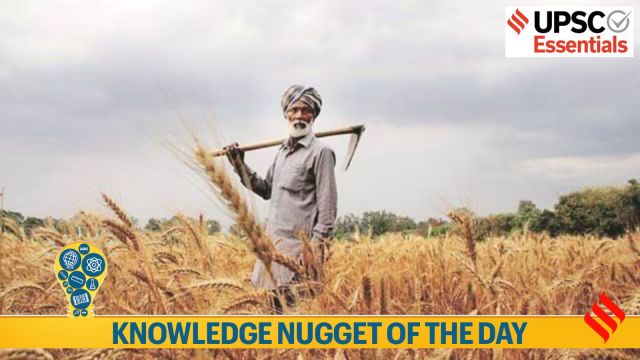The Union Cabinet on January 1, 2025, approved the continuation of two crop insurance schemes — the Pradhan Mantri Fasal Bima Yojana (PMFBY) and Restructured Weather-Based Crop Insurance Scheme (RWBCIS) until 2025-26. It also approved the creation of the Fund for Innovation and Technology (FIAT) with a corpus of Rs.824.77 crore.
Key Takeaways:
1. PMFBY was launched in 2016 to replace the existing National Agricultural Insurance Scheme (NAIS) and the Modified National Agricultural Insurance Scheme (MNAIS). It works on the One Nation, One Crop, One Premium. Under the scheme, all farmers including sharecroppers and tenant farmers growing “notified crops” in the “notified areas” are eligible for coverage.
2. Initially, the scheme was compulsory for loanee farmers; in February 2020, the Centre revised it to make it optional for all farmers.
3. The scheme’s objective is to stablise farmers’ income to ensure their continuation in farming, encourage them to adopt innovative agricultural practices, and ensure the flow of credit to the farmers. For this, the scheme provides insurance coverage to the farmers in the event of failure of any of the notified crops as a result of natural calamities, pests & diseases.
4. Under the PMFBY, a farmer is required to pay as a premium 2% of the sum insured or actuarial rate, whichever is less, for all kharif foodgrain and oilseed crops; 1.5% of sum insured or actuarial rate, whichever is less, for all rabi foodgrain and oilseed crops; and 5% for horticultural crops.
Story continues below this ad
5. In the initial scheme, the difference between actuarial premium rate and the rate of insurance premium payable by farmers, which is called the rate of normal premium subsidy, was to be shared equally between the Centre and states. However, states and Union Territories are free to extend additional subsidy over and above the normal subsidy from their budgets.
6. In February 2020, the Centre decided to restrict its premium subsidy to 30% for unirrigated areas and 25% for irrigated areas (from the existing unlimited). Earlier, there was no upper limit for the central subsidy.
 The horticulture insurance allows farmers to insure their horticulture crop by paying 5 per cent of the premium while the state and central government picks up the rest. (Express Photo by Harmeet Sodhi for representation)
The horticulture insurance allows farmers to insure their horticulture crop by paying 5 per cent of the premium while the state and central government picks up the rest. (Express Photo by Harmeet Sodhi for representation)
7. It also revised the guidelines in February 2020 stating that “The non-payment of the State Share of premium subsidy within the prescribed timelines as defined in the seasonality discipline will lead to the disqualification of the State Government to implement the scheme in the next season.”
8. While PMFBY is based on yield, RWBCIS is based on proxies. Farmers are provided insurance protection against adverse weather conditions such as excess rainfall, wind, and temperature. The number of insured farmers under RWBCIS is relatively low.
Purpose of FIAT
Story continues below this ad
1. The FIAT would be used towards funding technological initiatives under schemes such as Yield Estimation System using Technology (YES-TECH), Weather Information and Network Data Systems (WINDS), etc, as well as research and development studies.
2. YES-TECH uses Remote Sensing Technology for yield estimation with a minimum 30 per cent weightage to technology-based yield estimates. Nine states — Andhra Pradesh, Assam, Haryana, Uttar Pradesh, Madhya Pradesh, Maharashtra, Odisha, Tamil Nadu, and Karnataka — are implementing it.
3. WINDS, the statement said, envisages setting up Automatic Weather Stations (AWS) at the block level and Automatic Rain Gauges (ARGs) at the Panchayat level. “Under WINDS, a 5 times increase in current network density is envisaged to develop hyper-local weather data. Under the initiative, only data rental costs are payable by Central and State Governments,” it said.
BEYOND THE NUGGET: nano di-ammonium phosphate (DAP)
1. The Centre has extended a special subsidy of Rs 3,500 per tonne on di-ammonium phosphate (DAP), which was to end on December 31, for a further one-year period from January 1, 2025.
Story continues below this ad
2. DAP contains 46 per cent phosphorus, a key nutrient that crops require at the early stage of root establishment and development. Farmers apply it at the time of sowing along with seeds.
3. But the supply of the conventionally used granular DAP, the majority of which is imported, has been unreliable, with shortfalls and delays triggering panic among farmers. This is why agro-scientists and policymakers have long been exploring alternatives, such as Indian Farmers Fertiliser Cooperative Ltd-developed nano DAP.
4. The indigenously-manufactured nano DAP comes in liquid form. It is logistically easier to manage, and more cost-effective than the granular DAP. A 500 ml bottle of nano DAP, which costs Rs 600, is sufficient to cover one acre of land.
5. IFFCO officially launched Nano DAP in 2023, following the introduction of nano urea in 2021. These innovations are part of India’s broader strategy to reduce reliance on imported fertilisers.
Story continues below this ad
(Source: Simply Put | Fasal Bima: who’s in, out and why, PM Modi govt kicks off 2025 with agri push, Can nano DAP replace the conventional granular version in Punjab’s Rabi season?)
For your queries and suggestions write at khushboo.kumari@indianexpress.com
Subscribe to our UPSC newsletter. Stay updated with the latest UPSC articles by joining our Telegram channel – IndianExpress UPSC Hub, and follow us on Instagram and X.



 The horticulture insurance allows farmers to insure their horticulture crop by paying 5 per cent of the premium while the state and central government picks up the rest. (Express Photo by Harmeet Sodhi for representation)
The horticulture insurance allows farmers to insure their horticulture crop by paying 5 per cent of the premium while the state and central government picks up the rest. (Express Photo by Harmeet Sodhi for representation)






























